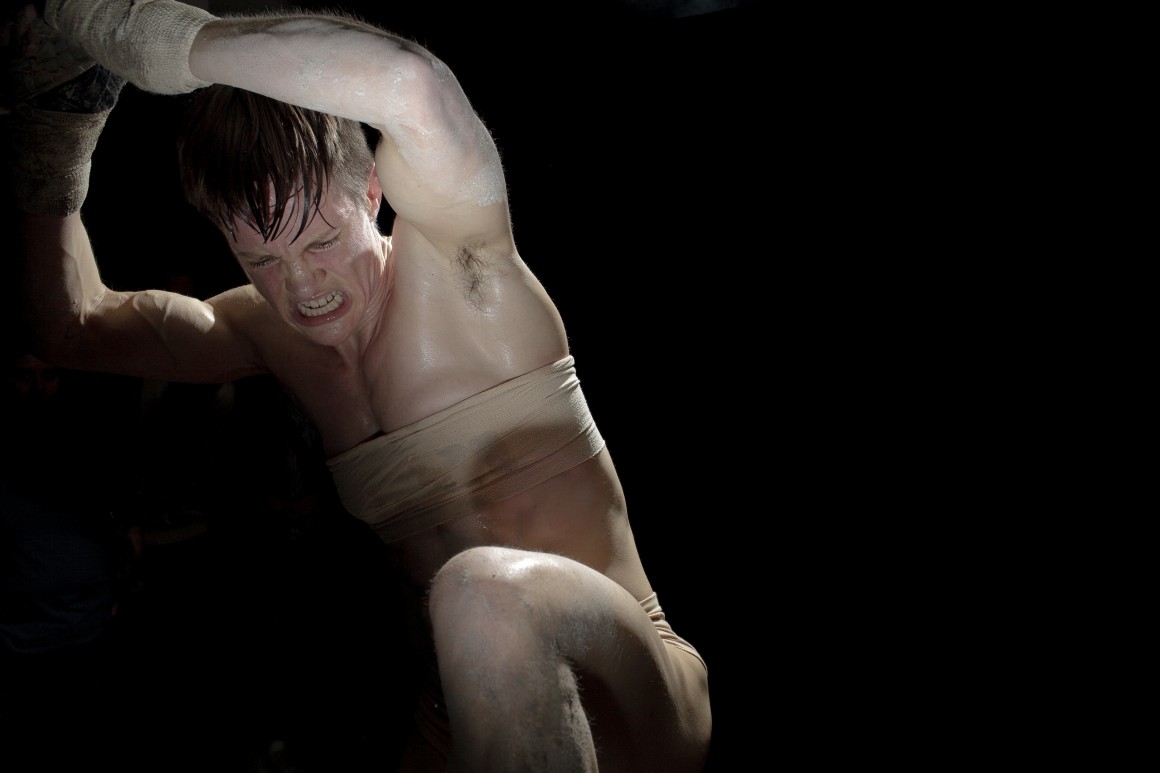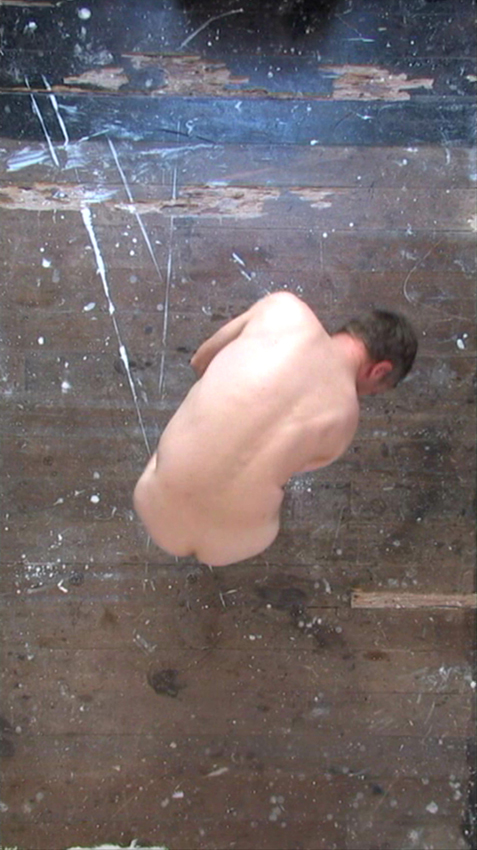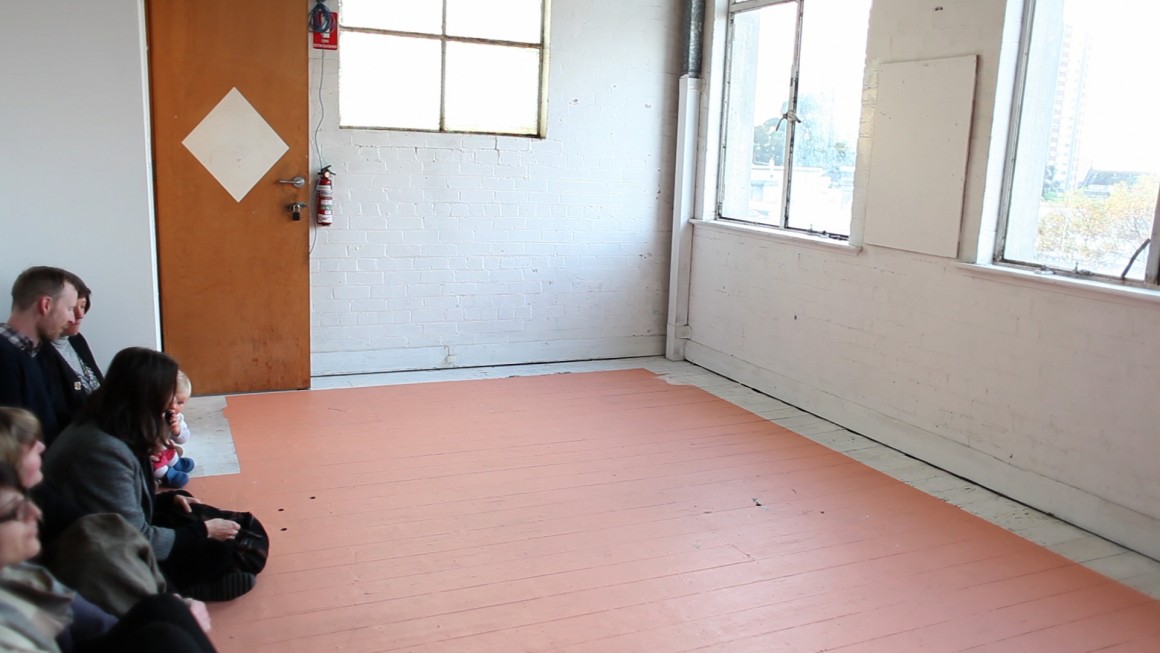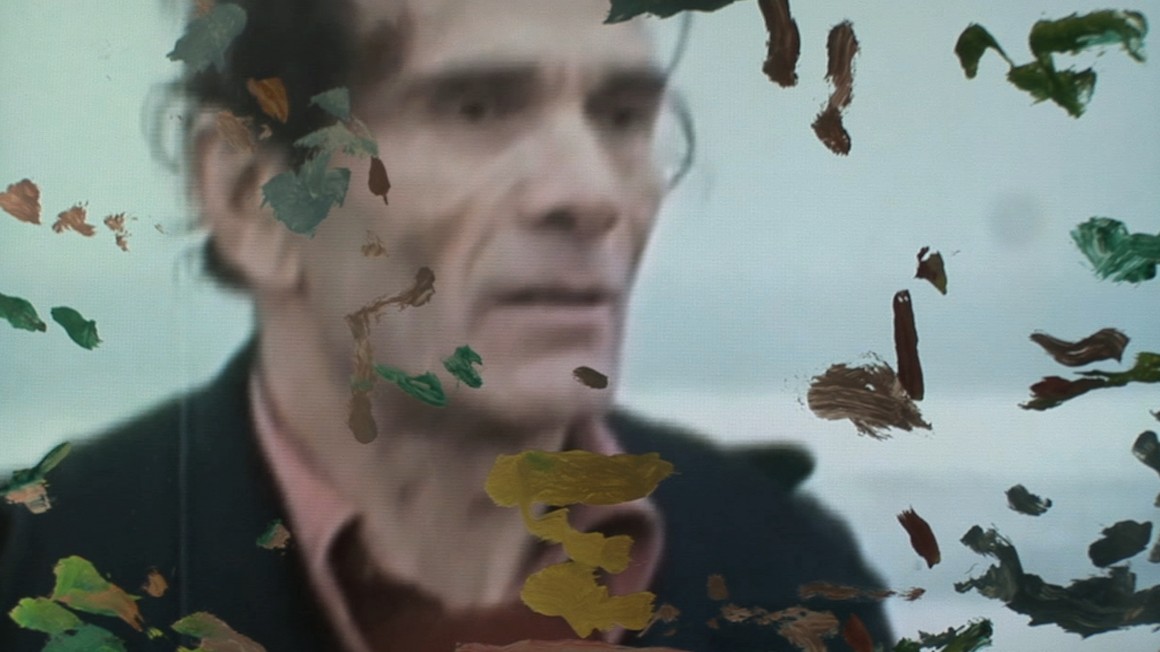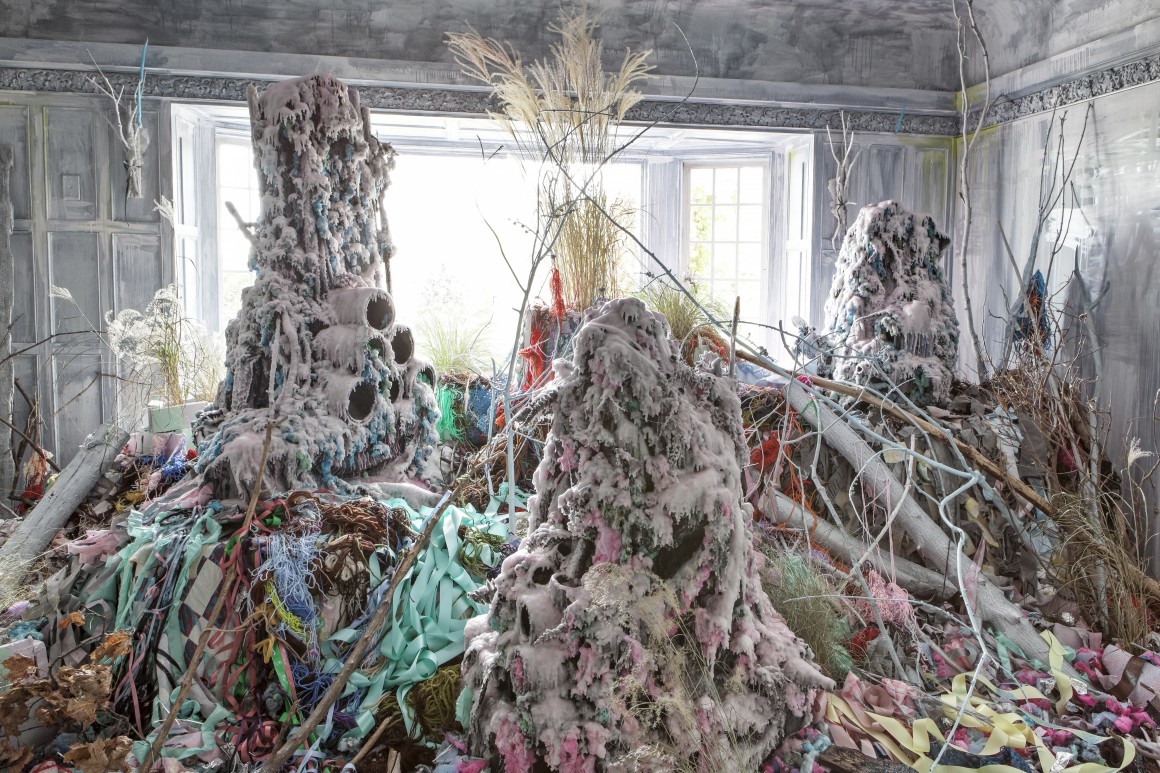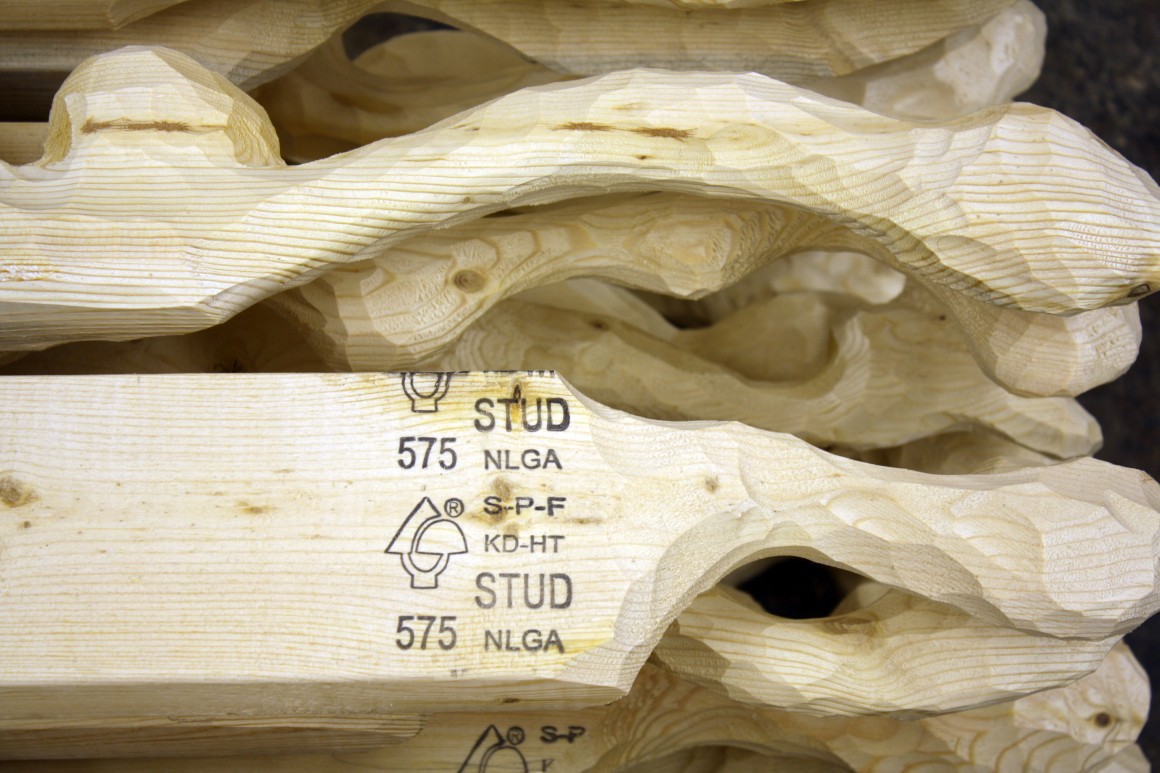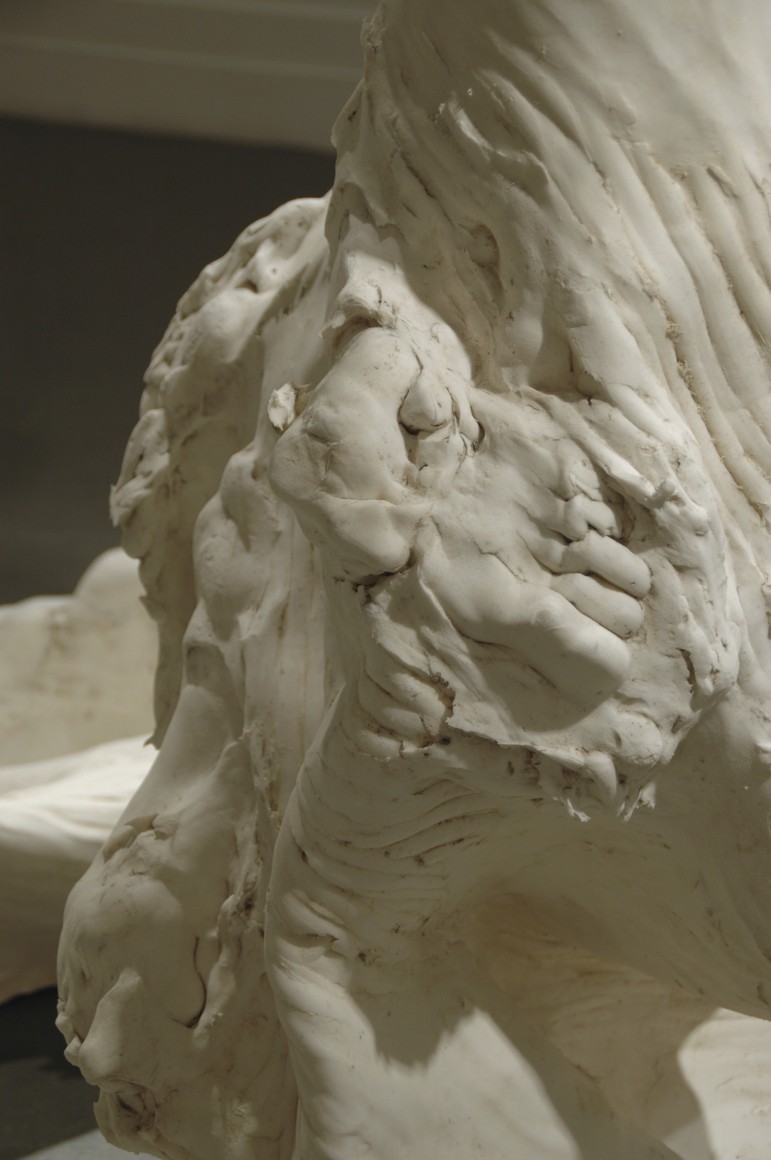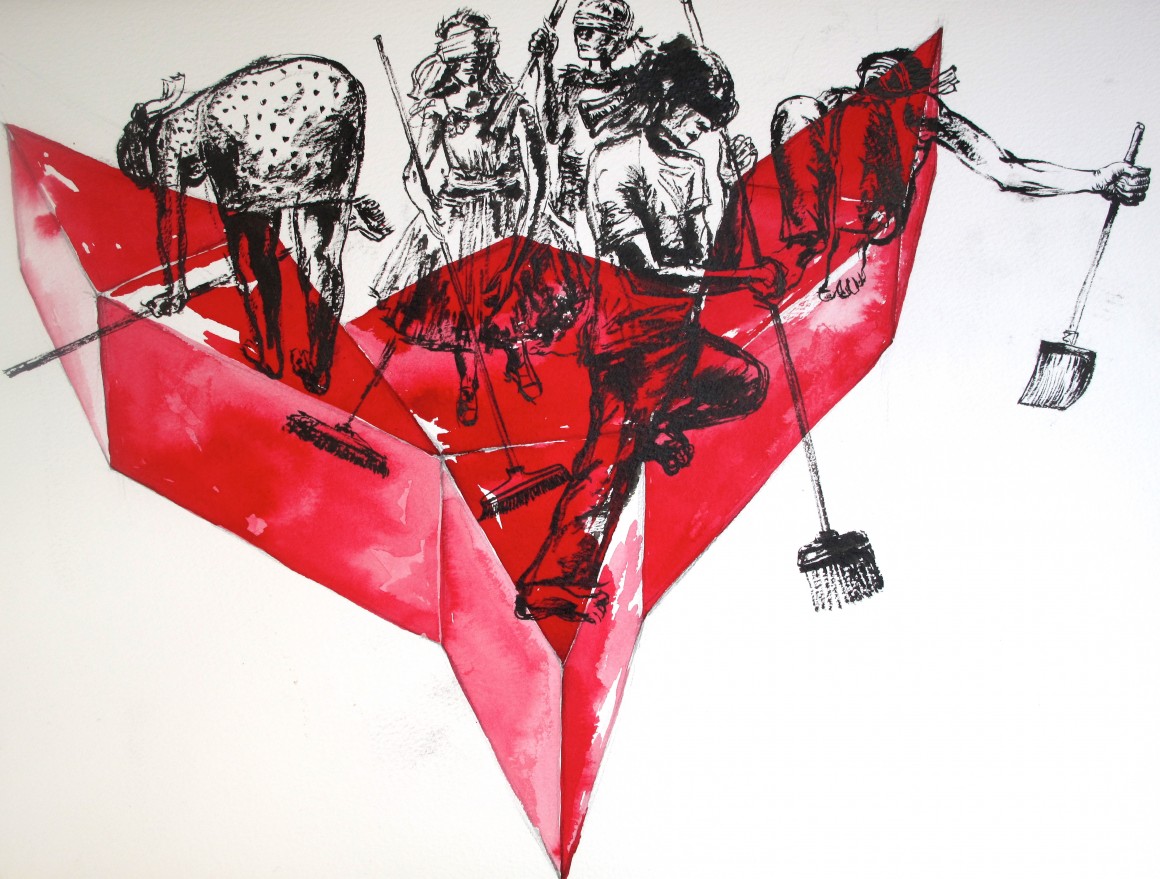In a well-established narrative of contemporary art in the Western European and North American contexts, after gestural abstraction swept the Western art world just after WWII, artists from the late 1950s onward began progressively to detach art from materiality. The rise of conceptual or “idea” art in particular, but also of performance, video, and other hybrid forms, confirmed a desire to critique the modernist obsession with “form” and a shift towards what art critic Lucy Lippard in 1973 famously called the “dematerialization of art.”i
The dematerialization in the 1960s and 1970s, however, was never full or complete and, in fact, one could argue that the interest in dematerialization actually pointed to a fascination or obsession with the material world both within and beyond the concerns of “art” per se. Working to challenge the conservative formalism attached to Abstract Expressionism and other mid-twentieth-century movements, artists in the 1960s and 1970s still grappled with and explored the limits of an anti-formalist materiality—particularly a materiality of the body, of industrial and post-industrial substances such as steel and Plexiglas, of new media forms such as video installation, and of the immediate social world. In fact the turn from materiality was more definitive from the early 1980s through the 1990s, a period in which dominant contemporary art practices in major Western art world centers did move more towards abstract concepts of critique, often implemented through appropriated imagery or objects that lacked “material” interest for artists and viewers. While expressionist paintings from Italy and Germany sold well in the marketplace in the 1980s, and were valued for their supposed “gestural” authority, the reigning art world interest, particularly in Anglo-American art criticism and art practices from centers such as New York and London, was in conceptual or “idea” art, and in the appropriation and reuse of pre-fabricated objects, images, and texts. Paradigmatic of this dematerialized work were the appropriated or industrially produced objects of artists such as Jeff Koons and Sherrie Levine and the text-image pieces or appropriated photographic pieces of feminist artists such as Barbara Kruger, Jenny Holzer, and Cindy Sherman.ii
Read moreMaterial Traces focuses on a new shift since the late 1990s back to a strong concern with materiality and with the traces of the activity of making art. In the past decade, artists have shown a strong interest in returning to hybrid modes of creativity that were developed in the 1960s and 1970s, but with a consciousness of the critical thinking and political emphases of conceptually driven works from the 1980s and 1990s. Material Traces presents a selection of this work from the past decade by mid-career artists (largely in their 30s and 40s) from Canada, the USA, Australia, New Zealand, and Great Britain—key sites of this new development. Foregrounding the process of making, and drawing on the legacy of performative, hybrid, “intermedial,” concept- and process-driven practices from the 1960s and 1970s, these works were produced through various modes of wrestling with materiality (obvious substances such as wood, paint, or even their own bodies) or through exploiting the specific ontological properties of a medium such as video (which might otherwise seem immaterial). They convey the signs of their own fabrication to present and future viewers.
– Amelia Jones
i Lucy Lippard, Six Years: The Dematerialization of the Art Object from 1966 to 1972 (1973; repr., Berkeley: University of California Press, 1997). Lippard’s concept has emerged recently as a key interest in rethinking narratives of contemporary art from this period. Vincent Bonin and Catherine Morris have curated a show with an accompanying catalogue, both entitled Materializing “Six Years”: Lucy R. Lippard and the Emergence of Conceptual Art, Brooklyn Museum (2012); and see also the book Ileana Parvu, ed., Objet en process. Après la dematerialization de l’art 1960-2010 (Geneva: Metispresses, 2012).
ii Technically, Cindy Sherman does not appropriate actual photographs; however, in the important “Untitled Film Stills” series of around 1980, her poses and the situations depicted are appropriated from classic Hollywood films.
CloseProduced with the support of the Frederick and Mary Kay Lowy Art Education Fund.
The Leonard & Bina Ellen Art Gallery’s contemporary exhibition program is supported by the Canada Council for the Arts.
Francis Alÿs, Christopher Braddock, Heather Cassils, Juliana Cerquira Leite, Andrew Dadson, Alexandre David, Paul Donald, Alicia Frankovich, Flutura And Besnik Haxhillari (Aka The Two Gulivers), Mark Igloliorte, Tricia Middleton, Alex Monteith, Angel Vergara
Curator: Amelia Jones
The Curator
Amelia Jones is Professor and Grierson Chair in Visual Culture at McGill University in Montréal. Her recent publications include major essays on Marina Abramović (in TDR), on feminist art and curating, and on performance art histories, as well as the edited volume Feminism and Visual Culture Reader (2003; new edition 2010). Her book, Self Image: Technology, Representation, and the Contemporary Subject (2006) has been followed in 2012 by Seeing Differently: A History and Theory of Identification and the Visual Arts and her major volume, Perform Repeat Record: Live Art in History, co-edited with Adrian Heathfield. She has curated exhibitions and events on feminist art, queer visual culture, and faith and identity in visual culture, among other things, including her flagship show Sexual Politics from 1996 at the UCLA Hammer Museum.
EXPLORE
- the various media and strategies that are represented by the works included in this exhibition.
- the relationships that exist between the works presented here.
- the roles that process and labour play in these works.
- the relationship that exists between performance and documentation. Consider the various forms that documentation can take, and the ways in which it co-exists with, defines the status of, and supplements performance.
- theatricality with respect to both the works presented and the viewer’s experience of them.
- the nature of relationship that exists between the viewer, the artwork, and the artist.
ADDITIONAL SOURCES OF INFORMATION
http://www.mcgill.ca/ahcs/faculty/jones
Jones, Amelia. Unpredictable Temporalities: The Body and Performance in (Art) History. In Performing Archives/Archives of Performance. Eds. Rune Gade and Gunhild Borggreen. Copenhagen: Museum Tusculanum Press, University of Copenhagen, forthcoming.
Heathfield, Adrian & Jones, Amelia (Eds.) Perform, Repeat, Record: Live Art in History. Bristol; Chicago: Intellect, 2012.
Jones, Amelia. Seeing Differently: A History and Theory of Identification and the Visual Arts. London; New York: Routledge, 2012.
Jones, Amelia. The Artist is Present: Artistic Re-enactments and the Impossibility of Presence. The Drama Review 55.1 (2011): 16-45.
Jones, Amelia. Performance, Live or Dead. Art Journal 70.3 (2011): 32-38.
Jones, Amelia (Ed.). The Feminism and Visual Culture Reader, 2nd Edition. London; New York: Routledge, 2010.
Jones, Amelia. The Televisual Architecture of the Dream Body. In It’s Time for Action (There’s No Option). About Feminism. Ed. Heike Munder. Zürich: Migros Museum für Gegenwartskunst; JRP Ringier Kunstverlag, 2008.
Jones, Amelia (Ed.). A Companion to Contemporary Art Since 1945. Malden: Blackwell Publishing, 2006.
Jones, Amelia. Rupture. Parachute 123 (2006): 15-37.
Jones, Amelia (Ed.). Self/Image: Technology, Representation, and the Contemporary Subject. London; New York: Routledge, 2006.
Jones, Amelia. Televisual Flesh: Activating Otherness in New Media Art. Parachute 113 (2004): 70-91.
Jones, Amelia. Body. In Critical Terms for Art History. Eds. Robert Nelson and Richard Shiff. Chicago: University of Chicago Press, 2003.
Jones, Amelia. The Artist’s Body/ The Negotiation of Social Space. In The Artist’s Body. Ed. Tracey Warr. London: Phaidon, 2000.
Jones, Amelia. Body Art/ Performing the Subject. Minneapolis: University of Minnesota Press, 1998.
CloseArtists
Born in 1959 in Antwerp, Belgium, Francis Alÿs originally trained as an architect. He moved to Mexico City in 1986, where he continues to live and work. The confrontation with issues of urbanization and social unrest in his new country of adoption inspired his decision to become a visual artist. Since 2004, his work has been represented by David Zwirner.
Francis Alÿs‘s art centres around observations of and engagements with everyday life. His multifaceted projects include public actions, installations, videos, paintings, and drawings. Across these different media, Alÿs presents a distinct poetic and imaginative sensibility towards anthropological and political concerns. His actions have involved traveling the longest possible route between locations in Mexico and the United States to highlight the increasing obstacles imposed along the border; pushing a melting block of ice through city streets; commissioning sign painters to copy his paintings; filming his efforts to enter the center of a tornado; carrying a leaking can of paint along the contested Israel/Palestine border; and equipping hundreds of volunteers to move a colossal sand dune ten centimeters.
THE WORK
Painting/Retoque
Ex-US Panama Canal Zone, 2008
Video documentation of an action
8 min. 28 sec.
Courtesy of the artist and David Zwirner, New York / London
Francis Alÿs‘s video Painting/Retoque shows him repainting by hand fading median strips on a road stretching across the Panama Canal. This mechanical, disciplined act calls attention to the mobility of geographical borders and the obliteration of territorial demarcations, while also presenting a tongue‐in-cheek comment on the status of painting and the touch of the artist.
ADDITIONAL SOURCES OF INFORMATION
Godfrey, Mark, Klaus Biesenbach, and Kerryn Greenberg, eds. Francis Alÿs: A Story of Deception. New York: Museum of Modern Art, 2010.
Bann, Stephen et al. Francis Alÿs: Fabiola: An Investigation. New York: Dia Art Foundation, 2008.
Medina, Cuauhtémoc. Francis Alÿs / Cuauhtémoc Medina, Russell Ferguson, Jean Fisher. London; New York: Phaidon, 2007.
Francbin, Catherine. Francis Alys: Le narrateur ou l’histoire sans fin / The Never-Ending Story. Art Press 369 (2010): 58-64.
Dezeuze, Anna. Walking the Line: Interview with Francis Alÿs. Art Monthly 323 (2009): 1-6.
Faesler, Carla. Francis Alÿs. Bomb 116 (2011): 64-71.
Herbert, Martin. The Distance Between: The Political Peregrinations of Francis Alÿs. Modern Painters March (2007): 84-89.
CloseChris Braddock is an artist and academic. He is Associate Professor of visual arts in the School of Art & Design, AUT University, New Zealand, and Chair of the AUT ST Paul St Gallery.
Chris Braddock’s art practice involves performance, video and sculpture. His theoretical research stems from the disciplines of art history, anthropology, and performance studies. Key terms that underscore Braddock’s art and writing: performative sculpture, part-object/ part-sculpture, moulds and casts, material trace, absence and presence of the body, labour of making, modes of participation, performance and its documentation, animism, contagion, art and spirituality, blasphemy.
I aim to explore sculpture and recorded/repeated bodies as ‘objects’ or ‘debris’ of performance. Bodies are traced in material substances, cast in appendages, or relayed through live and recorded performance. I’m interested in objects and images of encounter in difference to objects of recognition. In a deconstructive approach, material processes and performance take precedence. I seek out ambiguous, partial visual imagery and sounds that escape immediate comprehension. Tactical ‘trace structures’ provoke ideas of erasure where disappearance occurs in its appearance—a temporization and spacing that misconstrue dominant discourses about time, identities and place.
THE WORKS
Take series, 2007-2013
Epoxy clay
Courtesy of the artist
Part-sculptural objects in the Take series occupy a large plywood trestle-table designed to encourage interaction with the works. These objects are the result of pressing handfuls of epoxy clay against my body. Not the spaces between me and other things but the spaces ‘in-between’ my body. They bear the private blemishes, folds and impressions of my body and yet remain ambiguously indeterminate. They await further investigation as if calling forth reactions in potential participants.
Above, 2007
Video
28 min.
Courtesy of the artist
A white (naked) middle-aged man (me) grapples with something (silently) between his knees. You will never know what or its completion. The stage (if you can call it that) bears traces of some, or other, gesture. You (in space) ride over him (behind him) privy to his incessant labour. If this is ‘live’ it was not meant for public view…
ADDITIONAL SOURCES OF INFORMATION
Braddock, Christopher. Performing Contagious Bodies: Ritual Participation in Contemporary Art. London: Palgrave Macmillan, 2013.
Braddock, Christopher. Contagious Participation: Magic’s Power to Affect. Performance Research 16.4 (2011): 97-108.
Jackson, Anna. Dressed in Ambiguity. In The Artist Will Be Present. Ed. Christopher Braddock. Melbourne: School of Art, RMIT University, 2007: 2-6
Were, Virginia. Conjuring Tricks. Art News New Zealand 28.1(2008): 104-108.
CloseHeather Cassils is originally from Montreal and currently lives and works in in Los Angeles. She completed a BFA at the Nova Scotia College of Art And Design in 1996 and an MFA at California Institute of the Arts in 2002. Studying closely with her mentor Michael Asher, Cassils was inspired by the history of Womanhouse, the legacy of conceptual art, and institutional critique. Cassils is a founding member of the Los Angeles based performance group the Toxic Titties.
As an artist and a body builder I use my exaggerated physique to intervene in various contexts and question systems of power and control. My performances encompass all aspects of production: lighting, special effects, stunts, choreography, sound, and a highly trained and maintained body. I use my body to create “Social Sculpture”, showing how my process in performance reveals the relationship between thought, behavior and social systems.
THE WORK
Becoming an Image, 2012
Photo documentation of performance, clay
Photo: Heather Cassils and Eric Charles
Courtesy of Ronald Feldman Fine Arts, New York
Becoming an Image is a recent body of work consisting of a live performance, photographs, a sculpture and an audio piece. The performance is designed for the camera and more specifically for the act of being photographed. Taking place in a blacked out room, the only elements in the space are the audience, a photographer, the performer and a block of clay, similar in dimension to a body and weighing 1500 pounds. In the darkness, I use my skills as a boxer and Mixed Martial Arts fighter to literally beat the clay. A sculpting process results from my physical blows. The only light emitted during this performance comes from the flash mounted on the photographer’s camera. Bursts of light emitted by the flash allow the audience to glimpse moments of the performance, and the act of photographing the performance is the means by which the performance is made visible.
ADDITIONAL SOURCES OF INFORMATION
Lord, Catherine, and Richard Meyer. Art and Queer Culture. London: Phaidon, forthcoming.
Jones, Amelia. Lost Bodies: Early 1970s Los Angeles Performance Art in Art History. In Live Art in LA: Performance in Southern California, 1970 – 1983. Ed. Peggy Phelan. Abingdon; New York: Routledge, 2012.
Cassils, Heather, Clover Leary, and Julia Steinmetz. Behind Enemy Lines: Toxic Titties Infiltrate Vanassa Beecroft. In Commerce by Artists. Ed. Luis Jacob. Toronto: Art Metropole, 2011.
Doyle, Jennifer. Sex Objects: Art and the Dialect of Desire. Minnesota: The University of Minnesota Press. 2006.
Ross, Christine. The Aesthetics of Disengagement: Contemporary Art and Depression. Minnesota: The University of Minnesota Press, 2006.
CloseJuliana Cerqueira Leite is a Chicago-born Brazilian artist currently based in Brooklyn. She completed an MFA in Sculpture at the Slade School of Fine Art, followed by an MA in Drawing at Camberwell College of Arts. She has since exhibited her work internationally. Juliana is recipient of the 2006 Kenneth Armitage Foundations’s Young Sculptor Prize and the 2010-11 A.I.R. Gallery Fellowship in New York. She will be artist in residence at the Armando Alvarez Penteado Foundation in São Paulo, Brazil, during the spring of 2013.
Cerqueira Leite’s work engages the history of figuration, re-formulating representations of the human body to reflect volition and its material contingency in form. Her practice explores human control over matter and the body’s physical translation of temporality and desire. Primarily a sculptor, Leite questions the relevance of language-based syntax to material realities using simple directives to produce shape, employing activities such as digging, rolling, climbing, and falling, to resolve sculptural concerns. She also approaches these themes through drawings, photography and video. Leite’s practice unites performance with other media to represent the ambiguity and mutability at the core of everyday being. She endeavours to uncover the connections between the body as form, process, extension, and vessel.
THE WORK
the climb is also the fall, 2011
Silicone rubber, fiberglass, plastic, metal
Courtesy of the artist
ADDITIONAL SOURCES OF INFORMATION
Giles, Ian. Introduction: Juliana Cerqueira Leite. Art Licks Magazine 4 (2011).
Groves, Nancy. A fresh start with the arts: Turn off the treadmill and ditch the diets, says Nancy Groves, and look to these inspiring events for a restorative, nourishing beginning to the new year. The Independent, London: 3 January, 2011.
Blatt, Katy. On Time. London: The Courtauld Institute of Art, University of London, 2008.
Samman, Nadim. Juliana Cerqueira Leite: Works in Process. The Naked Punch 09 (2007).
CloseAndrew Dadson lives and works in Vancouver. He received a Bachelor of Fine Arts in integrated media from Emily Carr Institute in 2003. He has exhibited at Charles H Scott Gallery, Vancouver; 304 Days, Vancouver; Vancouver Art Gallery, Vancouver; The Power Plant, Toronto; Henry Art Gallery Seattle; David Kordansky Gallery, Los Angeles; Museum of Contemporary Art, Chicago; Kunstverein Freiburg, Germany; Galleria Franco Noero, Torino; Rosenblum Collection, Paris; and Xavier Hufkens, Brussels. Dadson is represented by Galleria Franco Noero in Torino, Italy.
I use paint to explore the limits of boundaries, whether static and opaque or permeable and imagined. Using a wide array of materials, from lawns to Iraqi voter ink to oil paint on canvas, I search for the spaces where society manifests these invisible distinctions, and how they can be subtly breached and stretched. Beyond the dichotomy between public and private, spiritual and secular, my practice suggests the persistence of personal intervention and the opportunity to then question where such boundaries begin and end.
THE WORK
White Plank Painting, 2010
Oil on canvas
Collection of Shabin Mohamed, Toronto
ADDITIONAL SOURCES OF INFORMATION
Krajewski, Sara, Jessica Powers, and Reid Shier. The Brink: Andrew Dadson. Portland: Publication Studio, 2012.
Speed, Mitch. Phantasmagoria. Frieze, 150 (2012): 252.
McLellan, Ashley. Phantasmagoria: Images Unveiled. Canadian Art. Web. 28 June, 2012.
Sandals, Leah. Sitely Premises: The Backyard as Studio. Canadian Art. Web. 28 April, 2011.
Andersson, Patrik, and Shep Steiner. On the Nature of Things. Kamloops: Kamloops Art Gallery, 2011.
CloseAlexandre David lives and works in Montreal. His work has been shown in various museums and galleries in Canada, the United Kingdom, the Netherlands, Austria, Switzerland and France. He has recently ( in 2012) shown his work at Art Metropole in Toronto and Gallery 101 in Ottawa. In 2011, he has exhibited his work in solo exhibitions at YYZ in Toronto, Espace Tilt in Lausanne, as well as Plein Sud and the Parisian Laundry in Montreal. He also participated in the last Triennale at the Montreal Museum of Contemporary Art. He’s represented by Parisian Laundry in Montreal.
My site-specific plywood sculptures, installations, and interventions in public spaces lie between architecture and sculpture, private and public, inside and outside, physical experience and mental representation, the functional and the useless. Through their structural simplicity, often revolving around a vocabulary of ramps, passages, doorways, tables, and benches, my pieces are explorations of the form and function of the built environment and are grounded in the relationship between visual experience and use. A familiarity, both in the materials and in the forms, incites physical engagement and active participation.
THE WORK
Untitled, 2013
In situ installation
Plywood
Courtesy of the artist
Our daily architectural experiences are a necessary background for this site-specific work built in the Gallery’s window. Architecture is not referenced as a subject, but this work relies on the way we walk alongside walls, turn corners, sit on benches, and observe others doing these same things. Differentiating between use and the visual and use is difficult as viewing this work through the Gallery’s windows is as much part of the experience as being seen engaging with the work, through these same windows.
ADDITIONAL SOURCES OF INFORMATION
Mavrikakis, Nicolas. Romantic Remarks. Espace 99 (2012): 6-10.
Fraser, Marie et al. La Triennial quebecoise 2011: Le travail qui nous attend. Montréal: Musée d’art contemporain de Montréal, 2011.
Fraser, Marie et al. La demeure. Montréal: Optica, 2008.
Tousignant, Isa. Woodworkers: Alexandre David, Stéphane La Rue and Québec’s New Minimalism. Canadian Art, 25.1 (2008): 44-48.
Godmer, Gilles. Alexandre David. Montréal: Musée d’art contemporain de Montréal, 2002.
CloseBorn in Auckland, New Zealand, Paul Donald has lived in Australia and the United Kingdom, and now lives and works in Montreal. Donald is a MFA graduate from Sydney University and has exhibited throughout New Zealand, Australia, North America, and the UK.
Donald’s work has always been motivated by curiosity about the way in which people, cultures, and nations define themselves, and a critical perspective on the identifications that ensue. Grappling with the limits of a diverse range of materials, from wood to paint to space, time, and the action of the body itself, Donald produces objects and situations that physically manifest his questioning of how identifications function. Corporeal effort changes materials into deliberately confusing hybrid “bodies” that turn binary thinking inside out, resisting “either/or” identifications.
THE WORK
Untitled (studs), 2012
Pine
Courtesy of the artist
In Untitled (studs) Donald extends his earlier series of carved wood pieces, which carry references both to the body and to actual marks, bodily made. Here he makes the process even more evident by leaving part of the industrially produced timber exposed. The organic quality of the carved ends, with wrought surfaces like tool handles, turds, or cocks laboriously whittled and shaped, contrasts with the everyday studs. Their rectilinear shape determines how far the carving can go, putting in play a marked tension between hand made and manufactured.
ADDITIONAL SOURCES OF INFORMATION
Jones, Amelia. Queer Feminist Durationality: Time and Materiality as a Means of Resisting Spatial Objectification. In Seeing Differently: A History and Theory of Identification in the Visual Arts. Ed. Amelia Jones. London; New York: Routledge, 2012.
Wolff, Sharne. Confidence, Excitement, Trepidation, Annoyance and Boredom. the art life. Web. 2 December, 2011.
Cross, David. Forcing Performance into the Exhibition Format. EyeContact. Web. 3 December, 2011.
Katz, Jonathan. Modest Proposals: Paul Donald’s Subversion of the Grand Gesture. Xtra Contemporary Art Quarterly 11.3 (2009): 56-59.
CloseAlicia Frankovich was born in New Zealand and currently lives and works in Berlin. She was a finalist for the Walters Prize 2012, and her work has been included in exhibitions held at Künstlerhaus Bethanien, Dublin Contemporary, and the School of the Art Institute of Chicago, among others. Frankovich’s performances have been presented at and organized by ARRATIA, BEER (Berlin) and the Frankfurter Kunstverein, THE OFFICE (Berlin) and Le BUREAU (Paris), Drei Schwestern (Berlin), La Gaîté Lyrique (Paris), and Salon Populaire (Berlin).
I am interested in spectatorship, as it relates to performance and exhibition, and in how viewers encounter art. I construct situations that are simultaneously spontaneous and controlled. People who perform in my works play themselves and are chosen as agents who embody their particular profession, sport or selected identity both as individuals and as groups. My performances are often formulated via instructions rather than rehearsals so that an element of the social can be performed live and instinctively. I am interested in underlining social conditions and alerting viewers, through embodied experience, to the conventions and forms of power inscribed in specific sites.
THE WORK
The opportune spectator, 2012-2013
Video documentation of a performance
Courtesy of the artist
ADDITIONAL SOURCES OF INFORMATION
Bywater, John. Alicia Frankovich Starkwhite. Artforum 50.9 (2012): 329.
Cormack, Emily. Alicia Frankovich. Frieze, vol. 147. Web. May 2012.
Delany, Max. Artists’ Proof #1. Victoria: Monash University Museum of Art, 2012.
Boenzi, Francesca and Dominic Eichler. Film/Body/Gesture, Alicia Frankovich: Book of Works. Berlin: Künstlerhaus Bethanien, 2011.
Lagnado, Lisette. Alicia Frankovich. In Ice Cream: Contemporary Art in Culture. London; New York: Phaidon, 2007: 112-115.
CloseAlbanian-born Flutura and Besnik Haxhillari, the Two Gullivers, studied visual art in Tirana, Lausanne, Berlin, and Montreal (UQÀM). Their work has been exhibited at the Venice Biennale (1999), in After the Wall Hamburger Bahnohf Berlin (2000), at the Beijing Biennale (2005), at VIVA Art Action (2006, 2010), in Montreal at the 4e Biennale du dessin (2012), in the Musée des beaux-arts de Mont-Saint-Hilaire, and other venues. They were included in Installation Art in the New Millennium (2003) and East Art Map (2006). They have also received grants from the Conseil des arts et des lettres du Québec, the Canada Council for the Arts, SSHRC, and FQRSC. Besnik Haxhillari is a full professor at Université du Québec à Trois-Rivières.
We have been working together since 1998, and as a couple of artists we have taken the name the Two Gullivers. The concept of Gulliver, inspired by Jonathan Swift’s tale, implies the ideas of travel, emigration, and moving as an integral part of the artwork. Our performative and interdisciplinary approach involves the search for identity and relations with the other. Our artworks are formulated through dialogue and arise from a composite, multiple identity resulting from constant negotiation. We produce exhibitions/events in which installations are animated by our presence, our performance, and viewers’ interactions. Our art is a platform for discussion and multifaceted exchange.
THE WORK
Star’s Anatomy series, 2011-
Watercolour and ink on paper
Courtesy of the artists
Star’s Anatomy is a series of preparatory drawings for a performance/installation project that consists of the construction and manipulation of a star-shaped modular sofa made of six separable pieces. The star will serve as a place for living and activity in an exhibition/camping/studio space. We will live, eat, sleep, draw, and read on the structure, much of the time in the presence of the public, invited guests or passersby. The different positionings of the pieces of the star will serve as a pretext for different activities, thus offering a constantly changing image. Through our preparatory drawings (several dozen of them), we are trying to imagine the performance. The drawings made before the performance reinforce the context of the project and the action to come. The performance becomes the pretext for an exploration with this core idea that moves between drawing and action. While referring obliquely to our childhood and youth in communist Albania, the project reflects a process of thinking about symbols and their many possibilities for interpretation and reconfiguration. The performance will take place in another space at the same time as the exhibition Material Traces. More documentation of the process may be added during the exhibition.
ADDITIONAL SOURCES OF INFORMATION
Krstich, Vesna. Gullivers’ Rehearsal: Works by The Two Gullivers. Toronto: Loop Gallery, 2011.
De Oliveira, Nicolas, Nicola Oxley, and Michael Petry. Installation Art in the New Millenium: The Empire of the Senses. London: Thames & Hudson, 2004.
Belu, Françoise. L’utopique transparence de l’être. Vie des Arts 49.198 (2005): 80.
Palmiéri, Christine. Le corps médiatique. Spirale 183 (2002): 41-42.
CloseMark Igloliorte is an Inuk artist born in Corner Brook, Newfoundland and grew up in Happy Valley-Goose Bay, Labrador. He is a multi-disciplinary artist working primarily painting and drawing while exploring practices of sculpture, performance, and new media. Igloliorte has been a recipient of the Newfoundland and Labrador Arts Council Visual Arts Grant, the Canada Council for the Arts Emerging Artist Grant, and has been recognized as a Labrador Inuit role model by the Nunatsiavut Government. Igloliorte lives and works in Sackville, New Brunswick. He is represented by Galerie Donald Browne, Montreal.
My work is based on observational oil painting as well as on sculpture and performance developed in relation to my Inuit background. The slower process of painting allows me to investigate perception and representation, while staging performances such as skateboarding on an Inuit Komatik and Komatik Box bring together cultures within and outside of myself. My current interest lies in developing these streams through stays in Hopedale, Nunatsiavut and through studio work.
THE WORKS
Untitled, from the series Observational Diptychs, 2010
Oil on phone book page
Courtesy of the artist and Galerie Donald Browne, Montreal
Untitled, from the series Observational Diptychs, 2010
Oil on phone book page
Courtesy of the artist and Galerie Donald Browne, Montreal
Untitled, from the series Observational Diptychs, 2010
Oil on phone book page
Courtesy of the artist and Galerie Donald Browne, Montreal
Untitled, from the series Observational Diptychs, 2010
Oil on phone book page
Courtesy of the artist and Galerie Donald Browne, Montreal
Untitled, from the series Observational Diptychs, 2011
Oil on phone book page
Courtesy of the artist and Galerie Donald Browne, Montreal
Untitled, from the series Observational Diptychs, 2011
Oil on phone book page
Courtesy of the artist and Galerie Donald Browne, Montreal
Untitled, from the series Observational Diptychs, 2010
Oil on phone book page
Collection of Jean Pitre and Claude Leclerc, Saint-Lambert
Untitled, from the series Observational Diptychs, 2010
Oil on phone book page
Collection Landriault-Paradis, Montreal
The focus of this work is observation through working with banality, repetition and shifts in scale. The banality of my subject matter – shoes, toolboxes, coat hangers, etc – allows me to focus on the act of observational painting through a series a diptychs. Variations in cropping and point of view suggest that no depiction has ultimate authority and any number of variations are possible.
ADDITIONAL SOURCES OF INFORMATION
Campbell, James D. Mark Igloliorte. Border Crossings 30.2 (2011): 106.
Fraser, Marie et al. La Triennial quebecoise 2011: Le travail qui nous attend. Montréal: Musée d’art contemporain de Montréal, 2011.
Delgado, Jérôme. Doubles visions : Mark Igloliorte et Juan Ortiz Apuy, deux artistes en émergence, présentent leurs premiers solos à Montréal. Le Devoir 5 February, 2011.
CloseTricia Middleton was the recipient of the Victor Martyn Lynch-Staunton Award for Visual Arts in 2010. Her recent solo exhibitions have been mounted at Musée d’art contemporain de Montréal (2009); Southern Alberta Art Gallery (2009); Artspeak Gallery, Vancouver (2011); Mercer Union, Toronto (2011); and Oakville Galleries, Oakville, Ont. (2012). Recent group exhibitions include Misled by Nature: Contemporary Art and the Baroque, Art Gallery of Alberta, Edmonton (2012); Nothing to Declare: Recent Sculpture from Canada, The Power Plant, Toronto (2010); the inaugural Québec Triennial, Musée d’art contemporain de Montréal (2008); and Dé-con-structions, National Gallery of Canada, Ottawa (2007). Her work is in the collection of the Musée d’art contemporain de Montréal.
Tricia Middleton’s sculptures and architectural installations propose hypothetical reverberations of a culture built around the unfettered production and consumption of inexpensive, disposable items of so-called use. Fascinated by the inevitable decline of all material towards collapse, Middleton zealously hoards and then repurposes the cast-offs from her studio production, amassing and grafting them onto one another to create synthetic objects and environments that mimic natural processes of accretion and decomposition. Her work traces the migration of form and meaning over time and, in so doing, strives to elucidate and overcome our heedless, if not apathetic attitude toward material culture.
THE WORK
Crones, 2013
Excerpted from Crones room: Form is the Destroyer of Force, Without Severity There Can Be No Mercy, 2012-2013
Installation
Wax, fabric, paint, found object, dust, glitter
Courtesy of the artist
Crones room: Form Is the Destroyer of Force, Without Severity There Can Be No Mercy depicts the uncanny aftermath of a natural disaster viewed now as an otherworldly ruin. Collapsing practices of painting, sculpture and architecture, this immersive environment is constructed through the accumulation of both materials and ideas. Crones considers the relationship between the natural and the cultural, where the laws that govern nature’s systematic creation, destruction and regeneration offer a rich allegory for the production of art and ideas.
ADDITIONAL SOURCES OF INFORMATION
Crowston, Catherine, Josée Drouin-Brisebois, and Jonathan Shaughnessy. Misled by Nature: Contemporary Art and the Baroque. Ottawa: National Gallery of Canada, 2012.
Grant Marchand, Sandra. Tricia Middleton: Dark Souls. Montréal: Musée d’art contemporain de Montréal, 2009.
Bélisle, Josée et al. Nothing is lost, nothing is created, everything is transformed: the Québec Triennial 2008. Montréal: Musée d’art contemporain de Montréal, 2008.
Drouin-Brisebois, Josée. De-con-struction. Ottawa: National Gallery of Canada, 2007.
CloseAlex Monteith was born in Belfast, Northern Ireland, in 1977, and moved to New Zealand in 1987. She completed a BFA in Photography, an MFA in Intermedia/Time Based Arts, and a Doctor of Fine Arts (DocFA) at the University of Auckland’s Elam School of Fine Arts where she currently holds a position as Senior Lecturer. In 2009, Monteith’s RNZAF Red Checkers project was featured in TVNZ 7’s New Artland series. Her work was included in the 4th Auckland Triennial in 2010. She received the Arts Foundation of New Zealand’s New Generation Award in 2008, and was a Walters Prize finalist in 2010. In 2012, the Museum für Moderne Kunst Frankfurt am Main presented her Composition with RNZAF No.3 Squadron. A competitive surfer, Monteith was the Irish National Women’s Champion in 2001 and has competed on the New Zealand, European and world circuits.
Simultaneously my works often reflect on the politics, limits and freedoms of contemporary human activity at the threshold of geographical or territorial extremes. In particular, I am interested in cultures whose activity base is sensitive—radically sensitive—to the physicality of larger landscapes.
THE WORK
Passing Manoeuvre with Two Motorcycles and 584 Vehicles for Two-Channel Video Installation, 2008
Two channel video projection, sound
13 min. 38 sec.
Courtesy of the artist
Auckland’s commuter traffic gridlock is the context for a 12 kilometre long continuous passing manoeuvre performed simultaneously by two motorcyclists. The riders are riding, not to commute Auckland’s infamous Northern Motorway traffic jams as they grind towards the Auckland Harbour Bridge, but rather to perform the commute for two onboard video cameras, using lane splitting practices of urban motorcyclists.
ADDITIONAL SOURCES OF INFORMATION
Cubitt, Sean, Daniel Palmer, and Les Walkling. Reflections on Medium Specificity Occasioned by the Symposium ‘Digital Light: Technique, Technology, Creation,’ Melbourne, 2011. Moving Image Review & Art Journal (MIRAJ), 1.1 (2012): 37-49.
Page, Maud. Unnerved: The New Zealand Project. Brisbane: Queensland Art Gallery, 2010.
Bryant, Jan. Image/War: The Absorbing and Apolitical Nature of the Everyday, Aesthetics and Play in Kathryn Bigelow’s Hurt Locker, Lee Miller’s Prison Guard and Alex Monteith’s Composition with Royal New Zealand Air Force Red Checkers. In Natural Selection 7 (2010): 131-133.
Laird, Tessa. Risk & the Politics of Place: Alex Monteith, Accelerated Geographies. Real Time Magazine, 100. 41 (2010): 41.
CloseAngel Vergara was born in Spain and currently lives and works in Brussels. He was educated at the École de recherche graphique (erg) and at the Académie Royale des Beaux-Arts (ARBA), both in Brussels. His work has been exhibited widely throughout Europe where it is held in several public collections including MuHKA (Belgium), SMAK (Belgium), FRAC (France). He represented Belgium at the 54th Venice Biennale in 2011.
His body of work comprises a wide range of media and disciplines, including performance, drawing, painting, video, and installation. Audiovisual material plays an important role in the majority of Vergara’s exhibitions, as well as making up a substantial part of his work. This material includes performance documents, excerpts from videos and installations, as well as autonomous film and video work. Continuous cross-fertilization between art and life is a major constant in Vergara’s work, with a particular focus on the social and cultural position of the artist’s position
THE WORK
FEUILLETON Berlusconi Pasolini, 2011
Three channel video installation, sound
Courtesy of the artist and Amine Rech Gallery, Brussels / Paris
Angel Vergara’s diptych Berlusconi Pasolini juxtaposes the position taken by each of these public figures with respect to mass media: Pasolini denouncing its standardizing effect, its flattening of Italian society into sterile conformity (including conformity in contestation), and Berlusconi controlling the national media but, in the end, powerless to govern.
ADDITIONAL SOURCES OF INFORMATION
Vergara, Angel. Angel Vergara: Feuilleton. Amsterdam: Ludion, 2011.
Ting, Selina. Interview: Angel Vergara. InitiArt Magazine. Web. 28 April, 2011.
Romanello-Hillereau, Tea. Luc Tuymans / Angel Vergara: Interview. Drome Magazine. Web. June 2011.
De Bruycker, Jasmine. Interview With Artist Angel Vergara, part 2. Base Now. Web. 15 October, 2010.
De Bruycker, Jasmine. Interview With Artist Angel Vergara, part 1. Base Now. Web. 8 October, 2010.
Close






